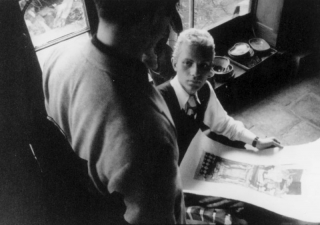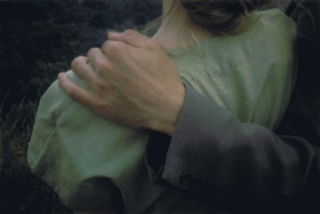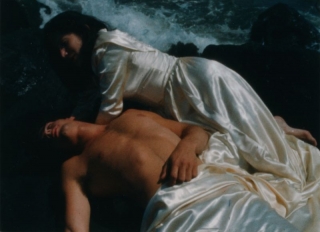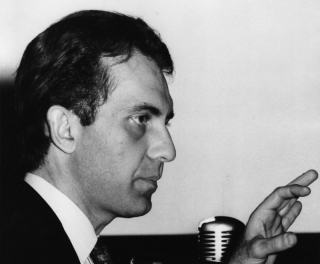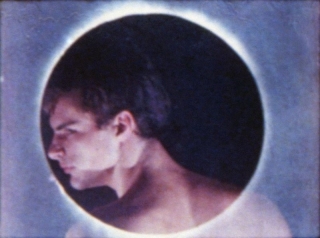Date: 19 September 2014 | Season: Gregory Markopoulos: Film as Film | Tags: Gregory Markopoulos
FILM AS FILM: THE CINEMA OF GREGORY MARKOPOULOS 1
Friday 19 September 2014, at 7pm
Cambridge Harvard Film Archive
“To be loved means to be consumed. To love means to radiate with inexhaustible light. To be loved is to pass away, to love is to endure.” (Text by Rainer Maria Rilke, recited on the soundtrack of Gammelion.)
Gregory J. Markopoulos, Bliss, 1967, 6 min
An exquisite portrait of the interior of a Byzantine church on the Greek island of Hydra, edited in-camera in the moment of filming.
Gregory J. Markopoulos, Gammelion, 1968, 55 min
Markopoulos’ elegant film of the castle of Roccasinibalda in Rieti, Italy, (then owned by patron, publisher and activist Caresse Crosby) employs an intricate system of fades to extend five minutes of footage to an hour of viewing time. This inventive new film form, in which brief images appear amongst measures of black and clear frames, was a crucial step towards Markopoulos’ monumental final work Eniaios (1947-91).
Followed by a conversation with P. Adams Sitney, Mark Webber and Robert Beavers.
Date: 20 September 2014 | Season: Gregory Markopoulos: Film as Film | Tags: Gregory Markopoulos
FILM AS FILM: THE CINEMA OF GREGORY MARKOPOULOS 2
Saturday 20 September 2014, at 7pm
Cambridge Harvard Film Archive
Introduced by Mark Webber
Gregory J. Markopoulos, Himself as Herself, 1967, 60 min
“Loosely based on Balzac’s novel Seraphita but merging its male and female protagonists, the film is at once melancholy and transcendent, laden with the gloom of what Markopoulos termed the character’s denial of self but also alive with the possibility of transformation. Clad in formal attire, the young hero seems the essence of maleness, yet he’s troubled by vaguely feminine objects – a fluttering fan, a gold-colorred foot standing on fur. Soon his masculine and feminine selves are intercut, the latter signaled not by drag but by a simple sari, as each of his identities appears to look and gesture at the other. The images are tinged with a powerful if partially suppressed eroticism, yet the plush interiors (this is a rich young man) trap us in a deadened world of opulence, the thick colors embedding the character in the decor. Most important, Markopoulos’s radical editing intercuts two or three scenes, sometimes in a single-frame flicker, which undermines the stability of any one locale or person, each image poised to escape its immediate moment.” (Fred Camper)
Gregory J. Markopoulos, The Dead Ones, 1949, 28 min
Markopoulos’ first attempt at making a 35mm feature film, clearly inspired by the cinema of Jean Cocteau, was left unfinished and the materials were lost for many years.
Gregory J. Markopoulos, Through a Lens Brightly: Mark Turbyfill, 1967, 15min
The life of painter, dancer and poet Mark Turbyfill, seen in his 70th year, is evoked through Markopoulos’ unique form of cinematic portraiture.
Date: 21 September 2014 | Season: Gregory Markopoulos: Film as Film | Tags: Gregory Markopoulos
FILM AS FILM: THE CINEMA OF GREGORY MARKOPOULOS 3
Sunday 21 September 2014, at 4:30pm
Cambridge Harvard Film Archive
Introduced by Mark Webber and Roy Grundmann
Gregory J. Markopoulos, Galaxie, 1966, 82 min
Galaxie is his intimate record of cultural luminaries in mid-1960s New York: 33 painters, poets, filmmakers, choreographers, and critics, including W. H. Auden, Jasper Johns, Susan Sontag, Paul Thek, Maurice Sendak, Shirley Clarke, George and Mike Kuchar, and Allen Ginsberg, whom he observed in their studios or homes and filmed in a single session. While Andy Warhol had his Screen Tests, and Brakhage and Jonas Mekas were also making their own beautiful film portraits, Markopoulos perfected a technique of layering and editing within his Bolex camera that had the effect, he noted, of making “the idea and the image more concentrated; the result a more brilliant appeal to the mind and dormant senses.” (Museum of Modern Art, New York)
Date: 22 September 2014 | Season: Gregory Markopoulos: Film as Film | Tags: Gregory Markopoulos
FILM AS FILM: THE CINEMA OF GREGORY MARKOPOULOS 4
Monday 22 September 2014, at 7pm
Cambridge Harvard Film Archive
Introduced by Robert Beavers
Gregory J. Markopoulos, A Christmas Carol, 1940, 5 min
Gregory J. Markopoulos, Christmas USA, 1949, 8 min
Gregory J. Markopoulos, Du Sang, de la volupté et de la mort, 1947-48, 70 min
Made as a USC student in Los Angeles, Markopoulos’ first 16mm film Psyche took as its source the unfinished novella of the same name by Pierre Louÿs. Shown together with Lysis and Charmides (both made on his return to Toledo, Ohio, and inspired by Platonic dialogues), it forms the trilogy titled Du sang de la volupte et de la mort (1947-48). By boldly addressing lesbian and homosexual themes, the trilogy gained unwelcome notices in Films in Review and Variety where, in the repressive atmosphere of the early 1950s, it was branded “degenerate” following a screening at NYU. Such a response is unimaginable today for lyrical works that express sensuality through the symbolic use of color and composition. Writing about these early films, Markopoulos chose to quote a statement by philosopher and theologian Mircea Eliade, offering viewers a clue to his entire body of work: “The whole man is engaged when he listens to myths and legends; consciously or not, their message is always deciphered and absorbed in the end.” The programme also includes his earliest film, an interpretation of Dickens made when the Markopoulos was only eight years old, and Christmas USA, in which documentary and fiction are woven together to convey a moment of awakening in the mid-West at the end of the 1940s. (Mark Webber)
Date: 28 September 2014 | Season: Gregory Markopoulos: Film as Film | Tags: Gregory Markopoulos
FILM AS FILM: THE CINEMA OF GREGORY MARKOPOULOS 5
Sunday 28 September 2014, at 4:30pm
Cambridge Harvard Film Archive
“Beloved spectators of my distant Temenos, what evolved was the ultimate concern for the medium of film. A continuous working decision not to betray you as film spectators; not to impose a message in your laps. But to deposit before you on a virile screen the very depths which concerned the present work in such a manner that you might one day at its presentation realize that I have been concerned always for you. I now repeat again the word, an effortless illusion and triumph with the legend of Faust; and, with the future film spectator of the Temenos supplying the very brilliance.” (Gregory J. Markopoulos)
Gregory J. Markopoulos, Genius, 1970/1989-91, 60 min
Portraits of the artists David Hockney and Leonor Fini are intercut with one of art dealer Daniel-Henry Kahnweiler. Initially Markopoulos shot three autonomous portraits, but he quickly came to believe that he had been making a version of Faustwithout realizing it. He first called the film The Illuminations of Faust and later settled on Genius. In his essay ‘The Redeeming of the Contrary’, published in the Spring 1971 issue of Film Culture, Markopoulos stressed the ambiguity of his creation and the intuitive nature of his working processes: “I had no idea that these three figures of the art world … would become the very elements of my Faust. And yet they did. They evolved, once the decision was made, effortlessly.” The spontaneity of this evolution from autonomous portraits of figures “sitting in their own rooms” lies at the core of what Markopoulos took to be his gift to his future audience. (P. Adams Sitney)
Gregory J. Markopoulos, Gilbert and George, 1975/1989-91, 12 min
A portrait of the British artists, two living sculptures, filmed in Paris on the occasion of their exhibition at the Sonnabend Gallery. (Mark Webber)
Date: 28 September 2014 | Season: Gregory Markopoulos: Film as Film | Tags: Gregory Markopoulos
FILM AS FILM: THREE FILMS BY GREGORY J. MARKOPOULOS
Sunday 28 September 2014, at 7pm
Basilica Hudson
Celebrating the publication of Film as Film: The Collected Writings of Gregory J. Markopoulos (The Visible Press), filmmaker Robert Beavers, and the book’s editor Mark Webber will present a very rare screening of three early Markopoulos films that were made in the United States in the mid-1960s.
Gregory J. Markopoulos, Ming Green, 1966, 7 min
Gregory J. Markopoulos, Twice a Man, 1963, 48 min
Gregory J. Markopoulos, Through a Lens Brightly: Mark Turbyfill, 1967, 14 min
Co-presented by Basilica Hudson and the Film and Electronic Arts Department at Bard College.
PROGRAMME NOTES
FILM AS FILM: THREE FILMS BY GREGORY J. MARKOPOULOS
Sunday 28 September 2014, at 7pm
Basilica Hudson
MING GREEN
Gregory J. Markopoulos, 1966, 16mm, colour, sound, 7 min
Dedicated to Stan Brakhage. Music: Traumen / Wesendonck Lieder by Richard Wagner. Filmed in New York City.
“An extraordinary self-portrait conveyed through multiple layered superimpositions of the filmmaker’s sparsely furnished room in Greenwich Village.” (Mark Webber)
TWICE A MAN
Gregory J. Markopoulos, 1963, 16mm, colour, sound, 48 min
Based on the story of Hippolytus. Featuring Paul Kilb, Olympia Dukakis, Albert Torgesen. Music: Excerpt from Manfred Symphony, op. 58 by Pyotr Tchaikovsky. Filmed in New York City, Staten Island, Long Island and Bear Mountain Park.
“Twice A Man is a fragmented re-imagining of the Greek myth of Hippolytus, who was killed after rejecting the advances of his stepmother. Markopoulos’ vision transposes the legend to 1960s New York and has its main character abandon his mother for an elder man. Employing sensuous use of colour, the film radicalised narrative construction with its mosaic of ‘thought images’ that shift tenses and compress time. One of the touchstones of independent filmmaking, Twice A Man was made in the same remarkable milieu as Scorpio Rising and Flaming Creatures by a filmmaker named ‘the American avant-garde cinema’s supreme erotic poet’ by its key critic P. Adams Sitney.” (Mark Webber)
THROUGH A LENS BRIGHTLY: MARK TURBYFILL
Gregory J. Markopoulos, 1967, 16mm, 15 min
Featuring Mark Turbyfill. Filmed in Chicago.
“The life of painter, dancer and poet Mark Turbyfill, seen in his 70th year, is evoked through traditional portraiture and personal objects.” (Mark Webber)
Back to top
Date: 29 September 2014 | Season: Gregory Markopoulos: Film as Film | Tags: Gregory Markopoulos
GREGORY MARKOPOULOS: COLLECTED WRITINGS
Monday 29 September 2014, at 7pm
New York The Kitchen
Celebrating the publication of Film as Film: The Collected Writings of Gregory J. Markopoulos (The Visible Press), filmmaker Robert Beavers, scholar Daniel Heller-Roazen, and the volume’s editor Mark Webber will lead a discussion of Markopoulos’ unique vision of film and the film spectator. Following the discussion will be a very rare screening of one reel of his magnum opus, Eniaios. This publication contains some ninety out-of-print or previously unavailable articles by the Greek-American filmmaker (1928-1992) who, as a contemporary of Kenneth Anger, Stan Brakhage and Andy Warhol, was at the forefront of a movement that established a truly independent form of cinema. Beginning with his early writings on the American avant-garde and auteurs such as Dreyer, Bresson, and Mizoguchi, it also features numerous essays on Markopoulos’ own practice, and on films by Beavers, that were circulated only in journals, self-published editions, or program notes. The texts become increasingly metaphysical and poetic as the filmmaker pursued his ideal of Temenos, an archive and screening space to be located at a remote site in the Peloponnese where his epic, final work Eniaios could be viewed in harmony with the Greek landscape.
In the last decades of his life, working quietly in Europe, Markopoulos re-edited his whole body of earlier films and dozens of new ones into one magnum opus, Eniaios. It is one of the longest films ever made: the complete film lasts approximately 80 hours and is divided into 22 cycles. From the moment he began to construct it, it was Markopoulos’ intention that Eniaios be projected only at the open-air site of what he called “The Temenos,” in a field near the village of Lyssaraia, the birthplace of his father in the Peloponnese of mainland Greece. For Eniaios, the summa of his career, Markopoulos wished to create a deeply personal and utterly unique cinematic experience. He chose the site for its natural beauty; he had conceived the Temenos as a viewing space where the physical environment would be in harmony with his idea of cinema as an instrument of philosophical and psychological revelation. In calling his projection space “The Temenos,” the filmmaker was invoking the religious traditions of ancient Greece, where a portion of land was set aside for the ritual worship of a god. The original meaning of the term “Temenos” is “a piece of land set apart.” Markopoulos wanted his life work shown in a space “set apart,” when after years of working in the international arena of the experimental film, he grew disillusioned with the interrelated commercialism of the film industry, the universities, and the art museums. He was convinced that the grandeur of what he called “film as film” required something radically different.
Gregory Markopoulos: The Collected Writings is made possible with support from Axe-Houghton Foundation and Lambent Foundation Fund of Tides Foundation, and in part by public funds from New York City Department of Cultural Affairs in partnership with the City Council and New York State Council on the Arts with the support of Governor Andrew Cuomo and the New York State Legislature.
Date: 5 October 2014 | Season: Gregory Markopoulos: Film as Film | Tags: Gregory Markopoulos
FILM AS FILM: THE CINEMA OF GREGORY MARKOPOULOS 6
Sunday 5 October 2014, at 7pm
Cambridge Harvard Film Archive
Gregory J. Markopoulos, Hagiographia II, 1970/1989-91, 60 min
Past the gates of the Temenos, and upon the twin hills the film spectator of the future will encounter the immeasurable works of Beavers and Markopoulos. On one hill will be the space of Beavers. On another hill there will be the space of Markopoulos. Here the film spectator of the future will devote himself to eternity, to the works of Beavers, to the works of Markopoulos. The spectres of distribution will have been vanquished; the spectres of projection will have been vanquished; the spectres of printing will have been vanquished. The patron of the Temenos will be he who is also unknown; hewho is without gifts of any kind; he who will be as immortal as the works being presented; he who will recognize that of all the arts only film needs a space in which to be seen; the rest is all artificial: museums, theatres and such. Only in the heart of the Peloponnesus, in Pelop’s land will film culture survive enhanced by the spirit of a truly simple and free people; the Greeks. The Greece today maligned by the truly lesser powers will be the victor.”(Gregory J. Markopoulos, The Filmmaker’s Perception in Contemplation, 1972)
Date: 9 October 2014 | Season: Gregory Markopoulos: Film as Film | Tags: Gregory Markopoulos
GREGORY J. MARKOPOULOS: TALK + SCREENING
Thursday 9 October 2014, at 5pm
Gent Film Plateau
To celebrate the publication of Film as Film: The Collected Writings of Gregory J. Markopoulos, the book’s editor Mark Webber will give an illustrated talk to introduce Markopoulos’ work, his extraordinary writings of cinema, and his landmark film Twice a Man (1963).
Gregory J. Markopoulos, Twice a Man, 1963, 48 min
Preceded by an illustrated talk by Mark Webber
“Twice A Man is a fragmented re-imagining of the Greek myth of Hippolytus, who was killed after rejecting the advances of his stepmother. Markopoulos’ vision transposes the legend to 1960s New York and has its main character abandon his mother for an elder man. Employing sensuous use of colour, the film radicalised narrative construction with its mosaic of ‘thought images’ that shift tenses and compress time. One of the touchstones of independent filmmaking, Twice A Man was made in the same remarkable milieu as Scorpio Rising and Flaming Creatures by a filmmaker named ‘the American avant-garde cinema’s supreme erotic poet’ by its key critic P. Adams Sitney.” (Mark Webber)
Featuring Paul Kilb, Olympia Dukakis, Albert Torgesen. Music: Excerpt from Manfred Symphony, op. 58 by Pyotr Tchaikovsky. Filmed in New York City, Staten Island, Long Island and Bear Mountain Park.
Presented by Courtisane, in collaboration with UGent – Vakgroep Kunst-, Muziek- en Theaterwetenschappen on the occasion of the course “Sleutelmomenten uit de geschiedenis van de experimentele film en videokunst” by Prof. Dr. Steven Jacobs.
Date: 10 October 2014 | Season: Gregory Markopoulos: Film as Film | Tags: Gregory Markopoulos
MARKOPOULOS 1
Friday 10 October 2014, at 8:30pm
Brussels Cinematek
Introduced by Mark Webber
Gregory J. Markopoulos, Twice a Man, 1963, 48 min
Gregory J. Markopoulos, Through a Lens Brightly: Mark Turbyfill, 1967, 14 min
A major achievement in Markopoulos’ research in terms of editing and the use of colour, Twice a Man is considered by many to be the filmmaker’s masterpiece. This contemporary transposition of the myth of Phaedra, aesthetically shattered, reinvents melodrama. Followed by a magnificent portrait of the dancer and poet Mark Turbyfill, whose vibrant images seem intertwined in an almost musical structure.

